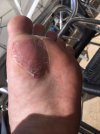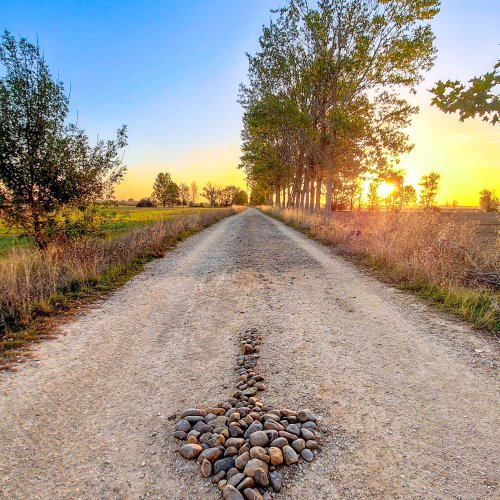No matter what I do, I always seem to get a few blisters. I've tried pretty much everything: one sock, two socks, different shoes, different brands of shoes, compeed, no compeed, taping, no taping, etc. No matter what, I can't stop blisters. Camino hike. Scotland hike. Canada hike. I seem to be able to slow them down, but they seem inevitable, which is unfortunate because it really does impact my enjoyment.
On my first CF, I started getting my first blisters walking into Zubiri on day two. By the time I hit Burgos I had people trying to convince me to go to the hospital they were so bad. I took two rest days then kept going. I think some of us are just prone to get them, unfortunately. That said, I do have some advice for people based on fighting blisters on multiple long distance walks..
1) Make sure your shoe fits. This is harder than it seems since over the course of a multi-day hike your feet will swell. So shoes that fit perfect on day 1 may not fit perfectly after a week (when I arrived in Santiago and picked up my suitcase I had shipped there, I couldn't fit into my regular shoes for about a week since my feet were so swollen). So I always end up getting my long distance hiking shoes a half size larger. For the first few days I can just double up on socks to get a better fit.
2) Learn how to tie your laces to lock your foot in place. You can't completely eliminate the friction inside a shoe, but good tying techniques will minimize it. Probably the worse location to get a blister IMO is the back of the foot, and that usually happens when the laces loosen. So the moment you feel some play in your shoes, stop and re-tie them.
3) When I first started getting blisters on the CF, a pharmacy gave me compeed. I thought this was the best invention ever as I just put them on all my blisters. But some of them ended up getting bigger underneath the compeed, since now the liquid had nowhere to go. It's very difficult to remove compeed as well, and often it will de-roof the blister in the process, which can be painful. It also complete trashes your socks. Because of all of this, I don't use or recommend it anymore.
4) There are always arguments for or against de-roofing (removing the skin from) blisters. I'm in the pro-removing camp, especially if I'm taking a rest day. I've had really bad blisters that bothered me for days that I decided to deroof manually. Once I did, and they dried out in a few hours, a scab formed quickly which was much preferable to having a liquid filled blister to step on for days. That said, if you do de-roof a blister, make sure you use sanitary practices and cover it with something sterile after.
5) Change your socks a few times a day. This is probably the best piece of advice I have. If forced to remove extra items from my bag, my socks would be the absolute last item I removed. I typically have 4-6 pairs now. They don't take up a lot of weight, and it lets me change them as much as I want. Plus, on nice days, you can simply pin them to the back of your pack and let them dry out. I would change them usually when I stopped for lunch (or second breakfast) and then keep going. But I think damp socks, which inevitable happens over the course of the day as your feet sweat (especially if like me you are carrying a bit of extra weight), are a huge contribution to blisters.
6) I always carry a few safety pins for 'popping' blisters since usually where I get them they become painful to walk on. Near the end of the CF I was literally popping one ever coffee stop just to keep going. Not much fun.
7) Pain management. I always carry some ibuprofen, and if that doesn't do the trick, chugging one back with a wine or a beer at a cafe often helps!
8) One sock vs two - some people claim one is better than the other, but I've tried both and they are both roughly the same to me. The idea behind two that instead of the friction happening between the shoe and your foot, the friction moves between the sock and the sock. But the thing is, I don't think you can control which part of your foot or sock gives under pressure, so I'm not sure how accurate that is myself. And one of the dangers with two socks is that your feet just become warmer and sweat more. While I'm on the fence about this, I find it easier just to have one sock that fits well these days. Easier to change as well at the half-way mark.
Here is a photo of one of my worse blisters from the CF, and the one I stopped in Burgos to take care of. It actually started as just a small one on the pad of my foot, which I quickly put compeed on. But as I kept walking on it, the liquid underneath the blister and the compeed just got pressed into the surrounding skin, and it just got progressively bigger each day. But the time I took the compeed off, it has swollen to this size, at which point I took time off and de-roofed it. This photo was the next day after de-roofing, and it mostly scabbed over.
So anyways, those are some of my tips. Like I said, I've never been able to remove them all on any long distance trek I've done, but each one seems to get a bit better. I've never spent a lot of time pre-taping my feet, so if anyone has done that and it's helped, please let me know (one of my worries was always that the tape itself would cause friction, defeating the point).
It took several months for all my blisters to heal after the CF, but the upside was my feet were super soft for about a year after the CF!






















